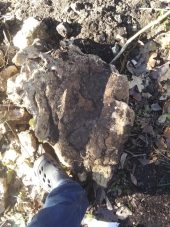Hey everyone!
I am new to the forum, and I signed up hoping to share thoughts and experiences about natural buildings.
I live in France and I have a kitchen garden with veggies and lots of herbs. I have a dog, three cats, 2 horses and many ducks, and oh, a husband!!!
I am a girl, but I do love to do all manners of non-girly things like building

I really am the builder here, although sometimes I can convince hubby to lift heavy stuff for me.
I am Kate; Vin is my favourite crowbar. We work wonders together.
Last year I started building a tiny cob shed, with the idea of learning the tecniques and materials for a future cottage (a tiny cottage, on the footprint of an ancient ruin we have on our land).
Late in the autumn I dug a foundation trench, as far down as I could, until I reached stone or really hard clay. In this spot, it makes for a prettz shallow foundation (more about that later). I made sure the foundation bottom slopes a little bit downhill so it serves as drainage too. Then I planted posts and built a reciprocal roof on the posts. All the timber came from our forest. They were all poles of chestnut that died on its feet. When I peeled the bark (with an old 2-handled drawknife, an invaluable tool), I could tell if the wood was too dicey (off to the stove!) or sound (up to the roof!).
There are several tutorials online onhow to build thiskind of roof. A small roof like mine (about 4 m across including the eaves) is dead easy to build, even alone.
The foundation was filled with small stones/gravel, and tamped hard.
Note that hereabouts we hardly ever have serious frosts (well, frost yes, but not to freeze the ground to any depth, really) and no earthquakes at all. So you can get away with very simple foundations. Even the old stone houses here don't have really much in the way of foundations, according to a friend of mine here who is a builder! In more difficult areas you will need more robust foundations.
Well, the stemwall was built with local stone around the posts. These are somewhat crappy stones, the good ones I kept for the cottage. The stones were stacked dry and then "mortared" with clay and sand, inside and out. The middle of the wall remains free draining.
This shed is just 2 m across inside (more or less round), but I made the walls 45 cm thick, so I could have shelves built into the volume of the walls (brilliant if you need to keep the floor area down!)
Over the reciprocal frame I made a ceiling of salvaged planks (this is where hubby came handy, to saw all those bits of planks!, oof!).
Over this I laid:
a vapour barrier (plastic sheet),
then lots of straw (not that insulation is much of an issue with this open shed, but it evens out the shape of the roof),
then lots of old sheets, recycled (to protect the waterproof membrane from the spiky straw ends),
then the waterproof membrane (2 layers of sturdy plastic sheet... pond liner much better for larger roofs!) with rain-spouts going from it through the eaves of the roof (more about that later)
then some rot-resistant polyestere fabrics, recycled (old parasols, and gazebo covers) to protect the mebrane from spiky things in the soil,
then the skylight (not glass, I am afraid of falling branches, but greenhouse plastic)
then topsoil mixed with old hay. The hay made the soil "fibrous" and helped it stick together when the roots of the plants had not developed yet.
This shed is in a lot of shade in summer so sedums and grass didn't seem a good choice. I planted a bunch of creeping things from the garden and forest,and it was a surprising success. In less than a year the roof really exploded with greenery. Species on my roof:
Ivy (hedera)
lesser periwinkle (vinca minor) (v.major would do to too, but it's such a thug!)
Bugloss (ajuga reptans)
lamiums (various)
ferns (various)
mosses (various)
strawberry (fragaria ananassa)
geranium machrorhyzum
potentilla quinquefolium
creeping charlie (glechoma hederacea)
sempervivums and wild sedums (these are suffering from the shade in summer, but they look good in winter)
*Geranium robertsiae* (herb robert: this I didn't plant, the seeds were in the forest topsoil: it went rampant and is glorious. Next spring the roof will be a pink cloud!) I definitely recommend this plant for similar conditions.
various grasses that came up from the hay including a few sprigs of barley!
various weeds and things that sprouted from the topsoil from seed.
All these things were planted in december (we have pretty mild winters) and were well rooted by the end of spring. Despite the appaling drought we are having, the roof remained green with only minimal watering. Maybe 5 or 6 times during the whole summer, for a couple o f minutes, with the hose.
The shed was left alone for the rest of the winter, while I worked on the future cottage stemwall beside it, and dug up lots and lots and lots, no, really LOTS of clay.
Ok, part 2 will follow soon, I promise.
You can see some pics here:
https://www.flickr.com/photos/mihara-kokonoe-tama/albums/72157685657647094
I will try to add more, especially of the early phases!

 10
10





 5
5






 2
2


























 1
1
















 4
4























